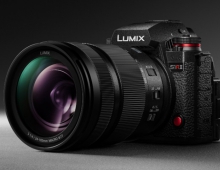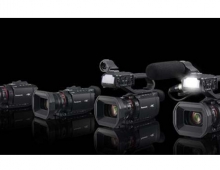
CES 2009: Panasonic Debutes 3D Full HD Plasma, Blu-ray Players
Panasonic is committed to brin
The 3D Full HD Plasma (3D FHD) system made its debut at October's CEATEC exhibition in Japan but is being displayed in the United States for the first time at CES. Panasonic's 3D Full HD Plasma Home Theater System enables the viewing of 3D FHD images by using a Panasonic 103-inch Plasma HDTV and a Panasonic Blu-ray Disc (BD) player, capable of distributing full High Definition (1920 x 1080 pixels) images to the left eye and right eye.
"This goes well beyond conventional 3D and Panasonic is fully committed to making it a reality, and soon," said Bob Perry, Executive Vice President, Panasonic Consumer Electronics Company. "Plasma is currently the only TV capable of delivering a 3D Full HD experience due in great part to its ability to refresh at a speed which enables multiple image display without loss of resolution. The integration of Hollywood?s 3D content with Panasonic?s industry leading Plasma, Blu-ray and 3D FHD technologies deliver a truly immersive experience which will elevate home entertainment to a whole new level of excitement. You will no longer just be watching a movie, you'?ll be experiencing the realism of Hollywood film."
The 3D experience occurs because the left and right eyes recognize different images. Panasonic?s 3D FHD system comprises a 103-inch Plasma HDTV and a Blu-ray Disc player that plays back Blu-ray Discs onto which 3D video (consisting of left- and right-sided 1080p Full HD images) are recorded. Full HD processing occurs on both the left- and right-sided 3D image in every single process - from recording, playback and display. With a special pair of active shutter glasses that work in synchronization with the Plasma HDTV, the viewer is able to experience 3D images formed with twice the volume of information as regular full HD images, and enjoy them together with high quality surround sound.
Previous consumer 3D entertainment encountered many different problems including the inability to deliver true High Definition picture quality in 3D due to the lack of bandwidth in transport and the limited capacity of the storage. Previous systems also suffered from reduced vertical resolution caused by a 3D display method that divides the scanning lines between the left and right eyes, and picture quality degradation caused by pixel skipping that results from the squeezing of two (left and right) screens' worth of full HD images into one screen of data capacity for image storage and transmission. Until now, there has not been a system capable of displaying the equivalent quality to the original Hollywood 3D master.
Panasonic's 3D FHD Plasma Home Theater System on display at CES 2009 integrates a wide range of technologies which eliminate the issues earlier systems encountered.
Plasma Display: The performance of Panasonic's Plasma panels, whose self-illumination allows for excellent video response, has been brought out to the fullest extent in the development of a 3D driving system that displays the left and right images together as full HD images with no resolution degradation.
Blu-ray Disc: Using the optical disc technology developed by Panasonic over many years, and the authoring technology developed by Panasonic Hollywood Laboratory (PHL), it has been possible to record 3D images -- consisting of respective left and right 1080p full HD images ? onto a single, standard Blu-ray Disc.
Blu-ray Disc Player: Panasonic has developed a technology to decode and play back the left and right full HD image data recorded to the Blu-ray Disc in real time.
3D Images: Panasonic has produced 3D content that allows the viewers to experience fascinating 3D images, including dynamic images of athletes at the Olympic Games, and animated movies from Hollywood.
Blu-ray Players on display
Panasonic also introduced the successors to last years' DMP-BD35 and DMP-BD55 players, as well as presenting the first Blu-ray-VHS dual player. All three of the new Blu-ray players ? DMP-BD60, DMP-BD80, DMP-BD70V - combine high quality images with enhanced networking functions, including VIERA Cast?s improved internet functionality that provides access to Amazon VOD?s huge selection of titles. The 2009 line of Blu-ray Disc players continue to incorporate VIERA Link, allowing the consumer to operate their audio/video components, via HDMI, with one remote. In addition, the new Blu-ray players have been designed to reduce power consumption.
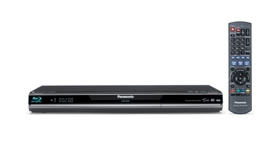 Each of the three models employs the PHL Reference Chroma Processor Plus. Developed in collaboration with Panasonic Hollywood Laboratory, this high image processing technology reproduces clear, vivid colors that are faithful to the original film. Panasonic?s three 2009 Blu-ray Disc players feature a high definition audio decoder (Dolby Digital Plus, Dolby TrueHD, DTS-HD Master Audio Essential) to take advantage of the high quality 7.1 channel surround sound now integrated in Blu-ray Discs. The DMP-BD70V distinguishes itself as the world?s first dual deck VHS-Blu-ray player, providing the consumer with a video product that features multi-format playback allowing the user to play VHS, CD, DVD and 1080p high definition Blu-ray Discs. The BD70V allows for premium 1080p up-conversion for all video formats.
Each of the three models employs the PHL Reference Chroma Processor Plus. Developed in collaboration with Panasonic Hollywood Laboratory, this high image processing technology reproduces clear, vivid colors that are faithful to the original film. Panasonic?s three 2009 Blu-ray Disc players feature a high definition audio decoder (Dolby Digital Plus, Dolby TrueHD, DTS-HD Master Audio Essential) to take advantage of the high quality 7.1 channel surround sound now integrated in Blu-ray Discs. The DMP-BD70V distinguishes itself as the world?s first dual deck VHS-Blu-ray player, providing the consumer with a video product that features multi-format playback allowing the user to play VHS, CD, DVD and 1080p high definition Blu-ray Discs. The BD70V allows for premium 1080p up-conversion for all video formats.
VIERA CAST technology, introduced in Panasonic's PZ850 2008 VIERA Plasma, is now available in Panasonic?s 2009 Blu-ray players. The internet enabled technology lets the consumer access the internet without the need of either an external box or a PC and enjoy the entertainment value provided by such targeted sites as Amazon VOD, with an extensive library of streamed titles, YouTube, Google's Picasa Web Album , Bloomberg and a weather channel. The DMP-BD60, DMP-BD80 and DMP-BD70V include an SD Memory card slot and USB slot, making it easy for the consumer to view and share both digital still images and HD video recorded with an HD camcorder in the AVCHD format.
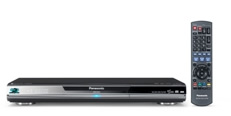 Panasonic?s Blu-ray players employ high precision 4:4:4 signal technology, which working in tandem with PHL Reference Chroma Processor Plus processes each pixel of the Blu-ray Disc video signal in the horizontal direction, to compliment vertical direction processing. P4HD (Pixel Precision Progressive Processing for HD) is another technology that contributes to the superior picture quality of the Blu-ray players. P4HD processes more than 15 billion pixels per second and applies the optimal processing to every pixel. Panasonic's Blu-ray players further utilize 16-level motion detection to categorize the image motion of each pixel into one of 16 levels; diagonal processing to detect diagonals and correct the pixels accordingly; 1080p up-conversion to up-convert content recorded in the 480i/p or 720p format to 1080p. The Blu-ray players also provide 1080/24p output, thereby reproducing cinema images from a Blu-ray Disc and DVD in their original 24p form with no need for conversion. This allows the user to enjoy cinema images in the same format used in cinema with a 1080/24p compatible TV.
Panasonic?s Blu-ray players employ high precision 4:4:4 signal technology, which working in tandem with PHL Reference Chroma Processor Plus processes each pixel of the Blu-ray Disc video signal in the horizontal direction, to compliment vertical direction processing. P4HD (Pixel Precision Progressive Processing for HD) is another technology that contributes to the superior picture quality of the Blu-ray players. P4HD processes more than 15 billion pixels per second and applies the optimal processing to every pixel. Panasonic's Blu-ray players further utilize 16-level motion detection to categorize the image motion of each pixel into one of 16 levels; diagonal processing to detect diagonals and correct the pixels accordingly; 1080p up-conversion to up-convert content recorded in the 480i/p or 720p format to 1080p. The Blu-ray players also provide 1080/24p output, thereby reproducing cinema images from a Blu-ray Disc and DVD in their original 24p form with no need for conversion. This allows the user to enjoy cinema images in the same format used in cinema with a 1080/24p compatible TV.
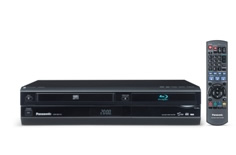 Complimenting the HD audio codecs the three Blu-ray players feature 96kHz surround re-master, a function that enhances the sound quality of CDs and other sources, and even improves the quality of the multi-channel audio data on Blu-ray Discs and DVDs. The DMP-BD80 further enhances the audio experience with 7.1 channel analog out to produce 7.1 surround sound. The BD80 also includes a playback information window that can be used to display detailed image information while a movie is playing.
Complimenting the HD audio codecs the three Blu-ray players feature 96kHz surround re-master, a function that enhances the sound quality of CDs and other sources, and even improves the quality of the multi-channel audio data on Blu-ray Discs and DVDs. The DMP-BD80 further enhances the audio experience with 7.1 channel analog out to produce 7.1 surround sound. The BD80 also includes a playback information window that can be used to display detailed image information while a movie is playing.
In order to obtain a reduction in power consumption the 2009 Blu-ray players use Auto Power Stand-By, a function that automatically turns off the player when you return to TV operation using the VIERA Link menu. In addition, the Stand-by Power Save automatically turns off the players' Quick Start function. When VIERA is turned on, Quick Start also turns on. In addition, the development of the UniPhier single chip LSI makes it possible to pack an entire video signal processing circuit onto a single chip. This helps lower power consumption, reduces the number of parts needed and allows for a more compact design. The BD60 consumes 16% less power in standby mode than last years' model, the DMP-BD35.
"This goes well beyond conventional 3D and Panasonic is fully committed to making it a reality, and soon," said Bob Perry, Executive Vice President, Panasonic Consumer Electronics Company. "Plasma is currently the only TV capable of delivering a 3D Full HD experience due in great part to its ability to refresh at a speed which enables multiple image display without loss of resolution. The integration of Hollywood?s 3D content with Panasonic?s industry leading Plasma, Blu-ray and 3D FHD technologies deliver a truly immersive experience which will elevate home entertainment to a whole new level of excitement. You will no longer just be watching a movie, you'?ll be experiencing the realism of Hollywood film."
The 3D experience occurs because the left and right eyes recognize different images. Panasonic?s 3D FHD system comprises a 103-inch Plasma HDTV and a Blu-ray Disc player that plays back Blu-ray Discs onto which 3D video (consisting of left- and right-sided 1080p Full HD images) are recorded. Full HD processing occurs on both the left- and right-sided 3D image in every single process - from recording, playback and display. With a special pair of active shutter glasses that work in synchronization with the Plasma HDTV, the viewer is able to experience 3D images formed with twice the volume of information as regular full HD images, and enjoy them together with high quality surround sound.
Previous consumer 3D entertainment encountered many different problems including the inability to deliver true High Definition picture quality in 3D due to the lack of bandwidth in transport and the limited capacity of the storage. Previous systems also suffered from reduced vertical resolution caused by a 3D display method that divides the scanning lines between the left and right eyes, and picture quality degradation caused by pixel skipping that results from the squeezing of two (left and right) screens' worth of full HD images into one screen of data capacity for image storage and transmission. Until now, there has not been a system capable of displaying the equivalent quality to the original Hollywood 3D master.
Panasonic's 3D FHD Plasma Home Theater System on display at CES 2009 integrates a wide range of technologies which eliminate the issues earlier systems encountered.
Plasma Display: The performance of Panasonic's Plasma panels, whose self-illumination allows for excellent video response, has been brought out to the fullest extent in the development of a 3D driving system that displays the left and right images together as full HD images with no resolution degradation.
Blu-ray Disc: Using the optical disc technology developed by Panasonic over many years, and the authoring technology developed by Panasonic Hollywood Laboratory (PHL), it has been possible to record 3D images -- consisting of respective left and right 1080p full HD images ? onto a single, standard Blu-ray Disc.
Blu-ray Disc Player: Panasonic has developed a technology to decode and play back the left and right full HD image data recorded to the Blu-ray Disc in real time.
3D Images: Panasonic has produced 3D content that allows the viewers to experience fascinating 3D images, including dynamic images of athletes at the Olympic Games, and animated movies from Hollywood.
Blu-ray Players on display
Panasonic also introduced the successors to last years' DMP-BD35 and DMP-BD55 players, as well as presenting the first Blu-ray-VHS dual player. All three of the new Blu-ray players ? DMP-BD60, DMP-BD80, DMP-BD70V - combine high quality images with enhanced networking functions, including VIERA Cast?s improved internet functionality that provides access to Amazon VOD?s huge selection of titles. The 2009 line of Blu-ray Disc players continue to incorporate VIERA Link, allowing the consumer to operate their audio/video components, via HDMI, with one remote. In addition, the new Blu-ray players have been designed to reduce power consumption.
 Each of the three models employs the PHL Reference Chroma Processor Plus. Developed in collaboration with Panasonic Hollywood Laboratory, this high image processing technology reproduces clear, vivid colors that are faithful to the original film. Panasonic?s three 2009 Blu-ray Disc players feature a high definition audio decoder (Dolby Digital Plus, Dolby TrueHD, DTS-HD Master Audio Essential) to take advantage of the high quality 7.1 channel surround sound now integrated in Blu-ray Discs. The DMP-BD70V distinguishes itself as the world?s first dual deck VHS-Blu-ray player, providing the consumer with a video product that features multi-format playback allowing the user to play VHS, CD, DVD and 1080p high definition Blu-ray Discs. The BD70V allows for premium 1080p up-conversion for all video formats.
Each of the three models employs the PHL Reference Chroma Processor Plus. Developed in collaboration with Panasonic Hollywood Laboratory, this high image processing technology reproduces clear, vivid colors that are faithful to the original film. Panasonic?s three 2009 Blu-ray Disc players feature a high definition audio decoder (Dolby Digital Plus, Dolby TrueHD, DTS-HD Master Audio Essential) to take advantage of the high quality 7.1 channel surround sound now integrated in Blu-ray Discs. The DMP-BD70V distinguishes itself as the world?s first dual deck VHS-Blu-ray player, providing the consumer with a video product that features multi-format playback allowing the user to play VHS, CD, DVD and 1080p high definition Blu-ray Discs. The BD70V allows for premium 1080p up-conversion for all video formats.
VIERA CAST technology, introduced in Panasonic's PZ850 2008 VIERA Plasma, is now available in Panasonic?s 2009 Blu-ray players. The internet enabled technology lets the consumer access the internet without the need of either an external box or a PC and enjoy the entertainment value provided by such targeted sites as Amazon VOD, with an extensive library of streamed titles, YouTube, Google's Picasa Web Album , Bloomberg and a weather channel. The DMP-BD60, DMP-BD80 and DMP-BD70V include an SD Memory card slot and USB slot, making it easy for the consumer to view and share both digital still images and HD video recorded with an HD camcorder in the AVCHD format.
 Panasonic?s Blu-ray players employ high precision 4:4:4 signal technology, which working in tandem with PHL Reference Chroma Processor Plus processes each pixel of the Blu-ray Disc video signal in the horizontal direction, to compliment vertical direction processing. P4HD (Pixel Precision Progressive Processing for HD) is another technology that contributes to the superior picture quality of the Blu-ray players. P4HD processes more than 15 billion pixels per second and applies the optimal processing to every pixel. Panasonic's Blu-ray players further utilize 16-level motion detection to categorize the image motion of each pixel into one of 16 levels; diagonal processing to detect diagonals and correct the pixels accordingly; 1080p up-conversion to up-convert content recorded in the 480i/p or 720p format to 1080p. The Blu-ray players also provide 1080/24p output, thereby reproducing cinema images from a Blu-ray Disc and DVD in their original 24p form with no need for conversion. This allows the user to enjoy cinema images in the same format used in cinema with a 1080/24p compatible TV.
Panasonic?s Blu-ray players employ high precision 4:4:4 signal technology, which working in tandem with PHL Reference Chroma Processor Plus processes each pixel of the Blu-ray Disc video signal in the horizontal direction, to compliment vertical direction processing. P4HD (Pixel Precision Progressive Processing for HD) is another technology that contributes to the superior picture quality of the Blu-ray players. P4HD processes more than 15 billion pixels per second and applies the optimal processing to every pixel. Panasonic's Blu-ray players further utilize 16-level motion detection to categorize the image motion of each pixel into one of 16 levels; diagonal processing to detect diagonals and correct the pixels accordingly; 1080p up-conversion to up-convert content recorded in the 480i/p or 720p format to 1080p. The Blu-ray players also provide 1080/24p output, thereby reproducing cinema images from a Blu-ray Disc and DVD in their original 24p form with no need for conversion. This allows the user to enjoy cinema images in the same format used in cinema with a 1080/24p compatible TV.
 Complimenting the HD audio codecs the three Blu-ray players feature 96kHz surround re-master, a function that enhances the sound quality of CDs and other sources, and even improves the quality of the multi-channel audio data on Blu-ray Discs and DVDs. The DMP-BD80 further enhances the audio experience with 7.1 channel analog out to produce 7.1 surround sound. The BD80 also includes a playback information window that can be used to display detailed image information while a movie is playing.
Complimenting the HD audio codecs the three Blu-ray players feature 96kHz surround re-master, a function that enhances the sound quality of CDs and other sources, and even improves the quality of the multi-channel audio data on Blu-ray Discs and DVDs. The DMP-BD80 further enhances the audio experience with 7.1 channel analog out to produce 7.1 surround sound. The BD80 also includes a playback information window that can be used to display detailed image information while a movie is playing.
In order to obtain a reduction in power consumption the 2009 Blu-ray players use Auto Power Stand-By, a function that automatically turns off the player when you return to TV operation using the VIERA Link menu. In addition, the Stand-by Power Save automatically turns off the players' Quick Start function. When VIERA is turned on, Quick Start also turns on. In addition, the development of the UniPhier single chip LSI makes it possible to pack an entire video signal processing circuit onto a single chip. This helps lower power consumption, reduces the number of parts needed and allows for a more compact design. The BD60 consumes 16% less power in standby mode than last years' model, the DMP-BD35.







